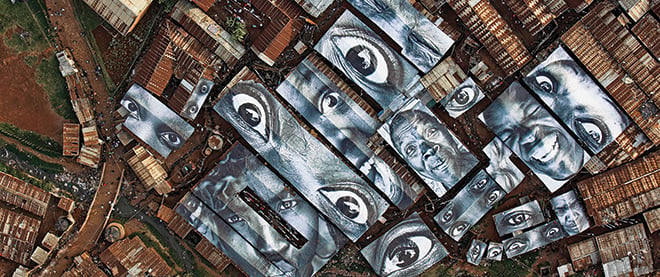Photographer and ‘artivist’ JR takes the art world by storm
‘The city was the best gallery I could imagine’
JR/ Agence Vu
Share

A girl sits in a mobile photo booth in Times Square and smiles into the lens as a flash lights her face. A minute later her portrait is printed, poster-sized. She’s given a brush and invited to paste her likeness on the sidewalk beside dozens of others, contributing to the giant black-and-white face mosaic. She’s part of Inside Out, a new work that sees photo booth trucks peppering landmarks in major cities, enticing civilians to participate in a public picture day.
The guy in the fedora nearby is facilitating the exhibition. He’s a photographer named JR, who caught the eye of the art world when his large-scale guerrilla photo projects went viral, leading to a turn at the Tate Modern’s 2008 street-art expo in London. When he won the TED Prize in 2011, the rogue “artivist” took on a Banksy-like cachet. Some countries tried to jail him for pasting photos in the streets. Now, he says, they invite him.
[mlp_gallery ID=271]
One of JR’s most popular projects was orchestrated in third-world slums, called Women Are Heroes. He punctuated shantytowns with giant photos of the faces of local women and displayed portraits the size of buildings, broadcasting a weary but steady gaze. It was as wondrous as it was empowering, says JR’s rep, Ralph Taylor from Lazarides Gallery in London. “To put someone’s face on a wall is to give them a sense of individuality,” he says. “Put the control in the hands of the subject and they’ll show you who they are.” JR’s intention is to show the face as the art, unfettered by setting, costume or action.
Comparisons have been made to Henri Cartier-Bresson, grandfather of the candid street capture, though not everyone thinks JR deserves the praise. “I’m not a huge fan,” says Rafael Schacter, author of The World Atlas of Street Art and, surprisingly, co-curator of that Tate Modern street-art show. “I’m not sure how empowering the favela images really are. It seems like it’s really for that final aerial shot.” How can it engage residents, he argues, when it’s only properly viewed from a helicopter? “There’s a touch of poverty chic there.”
Growing up in Paris, JR spent nights with friends tagging the city with graffiti until one day he found a camera on the metro and thought it might be more fun to document their illicit work. When he turned the lens on his crew, he found capturing their faces trumped capturing their tags. JR started to paste photocopies of the action shots around town, turning passersby into unwitting art patrons. “The city was the best gallery I could imagine,” he said. “I would never have to present my work to a gallery and let them decide if it was nice enough to show to people.” It was democratic—no filter between the public and art. During the 2005 French suburb riots, JR saw how protesters were depicted in the news; the media were like galleries, curating to give the public a manipulated view. If people could control their own image, he wondered, what would they show the world? JR wanted to make the model the message. He’d just be the middleman.
But the venue influences the work. Unlike the quiet stoicism conveyed by the models of Women Are Heroes, the photos of Inside Out lean toward the kind of cocky wink found in Instagram: the index finger as moustache, the Zoolander duck face. One woman even uses the platform to advertise, holding her business card beside her saleswoman-like smile.
“We First-Worlders love our selfies,” says social-media psychologist Pamela Rutledge, “but we always have.” Elites have been commissioning their likenesses for centuries, she notes. And unlike people in poorer countries, we’re used to seeing our own image, and our comfort in front of the camera should not be misconstrued as narcissism: that’s a pathology, she says, and mild interest in appearance is philosophically normal. “We create a sense of our own humanity when we can see ourselves apart from a crowd,” says Rutledge.
Many street artists are keen to get noticed through the skill of their drawing or the wit of a stencil. JR attempts to make waves not by showing us how he is, but how we are. It can never be a completely unfiltered version—he chooses the location and class of his participants. But a face, however framed, reflects a narrative. And the camera never lies.